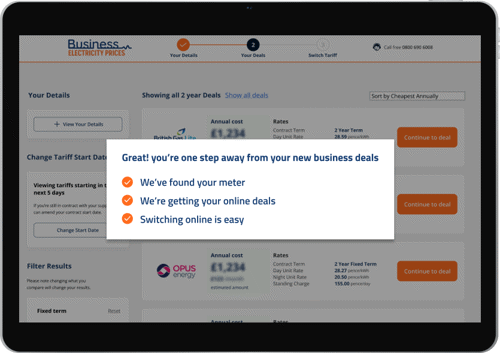Standing Charges Explained
The Impact On Your Business Electricity & Cheapest Standing Charges
The cost of a standing charge on your business electricity bill can be significant. Some customers may benefit from a no-standing charge tariff; this guide helps you understand these charges and how they relate to your electricity bill.

What Is a Standing Charge?
A standing charge is a fixed daily fee paid to your business electricity supplier for supplying power to your premises. This is a fixed amount and you will pay regardless of the electricity you use. This applies to businesses regardless of being operational or not.
This charge covers the cost it takes for the supplier to deliver electricity to your business premises. The cost of Standing Charges vary from supplier, tariff and region.
Typical, suppliers cover the costs of the following using standing charges:
- Network maintenance
- Upkeep of your connection
- Meter readings/ other admin costs
- Government initiatives
Can I Get A No Standing Charge Tariff?
When switching providers you may come across the term 'electricity daily standing charge'. These charges are applied regardless of the amount of electricity you use, or some providers offer a no-standing charge tariff. Recently, we have not seen any suppliers offer a tariff with no standing charge but that doesn’t mean we won’t see them again in the future.
When we have seen them in the past, suppliers typically offset any standing charge losses by charging a higher unit price. This makes them appealing to certain types of businesses that are not open regularly throughout the week.
Suppliers are currently charging anywhere between 25p right to 160p per day as a standing charge. This can add a few hundred pounds to your annual bill and this can have an impact on a business.
Business Electricity Suppliers Offering The Cheapest Standing Charges - January 2024
| Supplier | Tariff Name | Tariff Length | Daily Standing Charge | Annual Standing Charge Cost |
|---|---|---|---|---|
| British Gas Lite | BGLite Dec 2023 V70Love 12 | 3 | Single Rate | 2 years | 40p | £146 |
| Valda Energy | Valda Energy 3UR_3.12.12 Single Rate LSC | 1 year | 43p | £156.95 |
| British Gas Lite | BGLite Dec 2023 V70Love 12 | 3 | Single Rate | 3 years | 45p | £164.25 |
| Scottish Power | For Business vR2 ADV | 1 year | 51p | £187.10 |
| Scottish Power | For Business vR2 ADV | 2 year | 51p | £187.10 |
Standing charge prices are based on internal data for businesses located in London (Region 12) using 25,000 of electricity annually.
Standing Charge Prices By Region - January 2024
Where your business is located regionally will have an impact on the price of the daily standing charge you pay. Here are the three cheapest and most expensive regions for average standing charges based on usage of 25,000 kWh.
The Three Cheapest Average Regional Standing Charges
| Region | Daily Standing Charge | Annual Standing Charge Cost |
|---|---|---|
| London | 60.6p | £221.19 |
| East England | 66.6p |
£243.09 |
| South East England | 71.4p | £260.61 |
The Three Most Expensive Average Regional Standing Charges
| Region | Daily Standing Charge | Annual Standing Charge Cost |
|---|---|---|
| North Wales, Merseyside & Cheshire | 98.1p | £358.06 |
| Central & Southern Scotland | 96.1p | £350.76 |
| North East England | 87p |
£317.55 |
Regional standing charge prices are based on internal data for using 25,000 of electricity annually.
Why Are Electricity Standing Charges So High?
Standing charges on electricity are at an all-time high, and they don’t seem to be coming back down. This means that any savings made on less consumption are less significant than they would have been previously as a standing charge is applied to your bill regardless of how much electricity is being used.
Ofgem, the energy industry regulator, sets the level of both unit rates and standing charges; whilst the price cap does not directly impact business electricity, quite often it has a knock-on effect. Whilst suppliers can freely charge a lower standing charge, the overall costs of sourcing energy have increased.
What Does A Standing Charge Include?
The standing charge is typically spread equally and can get quite complex varying depending on the supplier. According to Money Saving Expert, a standing charge is typically split like this:
- Operating costs - 45%
- Network costs - 36%
- Policy costs (green levies, warm home discount etc) - 7.4%
- Smart metering - 5.2%
- Adjustment allowance (covid debt) - 0.3%
- Payment method costs - 3.3%
- Profit - 1.9%
- Allowance for unexpected costs - 0.9%
Average Standing Charge Prices 2024
A small business in the 5,000-15,000 kWh annual electricity usage band can expect to pay a daily standing charge of 78.3p, on a two year contract.
This table outlines how standing charges for electricity have decreased significantly in 2024 now, £66.43 a year less in daily standing charges.
| Year Average | Standing Charge | % Change On Previous Year | Annual Standing Charge Cost On Bill |
|---|---|---|---|
| 2019 | 28.39p | n/a | £103.62 |
| 2020 | 27p | -4.89% | £98.55 |
| 2021 | 28p | +3.70% | £102.20 |
| 2022 | 43p | +53.57% | £156.95 |
| 2023 | 98.3p | +128.6% | £358.79 |
| 2024 | 80.1p | -18.51% | £292.36 |
Data correct as of January 2024. Prices reflect a live market and are subject to fluctuation.
Does A Higher Standing Charge Make A Difference To Your Bill?
In most cases, it is better to select a business electricity tariff with a lower unit rate and a higher standing charge. However, each business is different and should be calculated before making this decision.
For example, if we look at the average daily standing change for 2023, this is what it would look like annually.
51.2p x 365 = £186.88
In relative terms, this is a much lower amount added to your bill in comparison to a business that has a higher electricity consumption with a higher unit rate and a low or no standing charge.
Which Type of Businesses Could Benefit From a No Standing Charge Tariff?
Zero-standing charge tariffs are typically best suited to businesses that operate infrequently or seasonally, as they won’t be charged for the periods when energy is not used. If your business is only open on weekends or for a few days a week, a tariff without a standing charge could also be of benefit to you.
Businesses that frequently remain open are not suited to no standing charge electricity tariffs as the higher unit rates can cause energy bills to increase.
How do I get Business Electricity Without a Standing Charge?
Almost all of the major six business energy suppliers in the UK have offered a no-standing charge tariff in the past. However, we have not seen one offered from any suppliers for a few years. This does not mean they won’t come back now that the energy market has stabilised.
Getting an Online Quote
At Business Electricity Prices, the only information we need to help you find great no-standing charge tariffs is your supplier's name, business address and a few contact details.
You can then view the latest electricity deals from the widest possible range of suppliers covering both standing charge and no standing charge tariffs.
Many types of tariffs come with no standing charge, so it’s best to use an energy comparison engine to give you a quote for your premises to see what is available to you.
Tools & Guides
- Commercial Gas Safety Guide
- Energy Price Cap Explained
- Online Cost Calculators
- Business Electricity with a Change of Tenancy
- Wholesale Market Data
- Energy Brokers
- The Climate Change Levy
- What are MPAN and MPRN Numbers?
- VAT on Business Electricity Explained
- Business Electricity Audits
- Smart Export Guarantee Guide
- Voltage Optimisation Explained
- Standing Charges Explained
Suppliers
-
 British Gas, the UK’s largest supplier
British Gas, the UK’s largest supplier -
 EDF, French-owned supplier leading in renewable electricity
EDF, French-owned supplier leading in renewable electricity -
 A dedicated supplier for large businesses
A dedicated supplier for large businesses -
 E.ON Next, a dedicated supplier for small businesses
E.ON Next, a dedicated supplier for small businesses -
 SSE (Southern Electric), flexible tariffs to suit a variety of businesses
SSE (Southern Electric), flexible tariffs to suit a variety of businesses -
 ScottishPower supplies gas & electricity to the UK
ScottishPower supplies gas & electricity to the UK
Compare business electricity rates
Save money on your electricity bills in just 30 seconds









